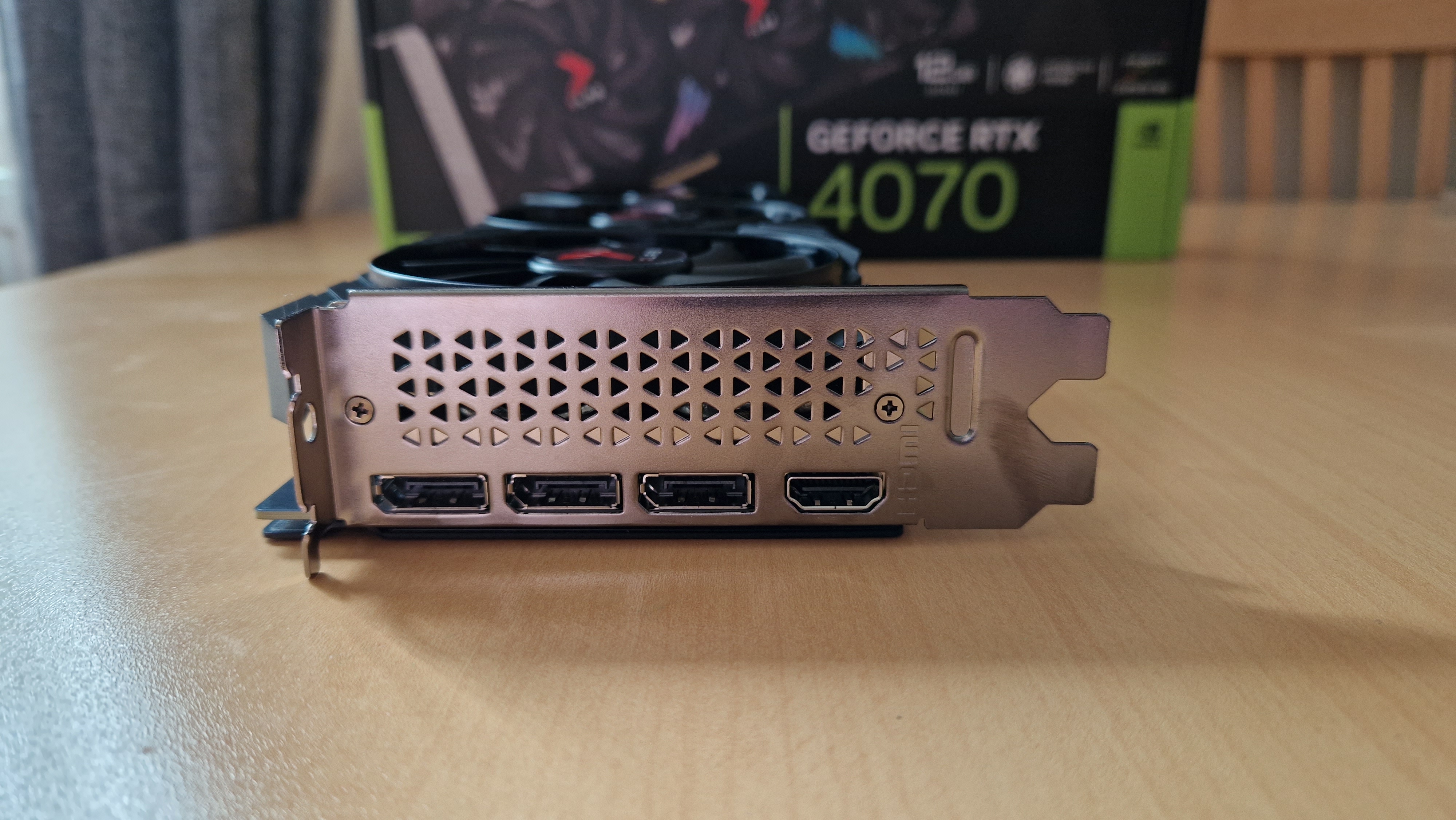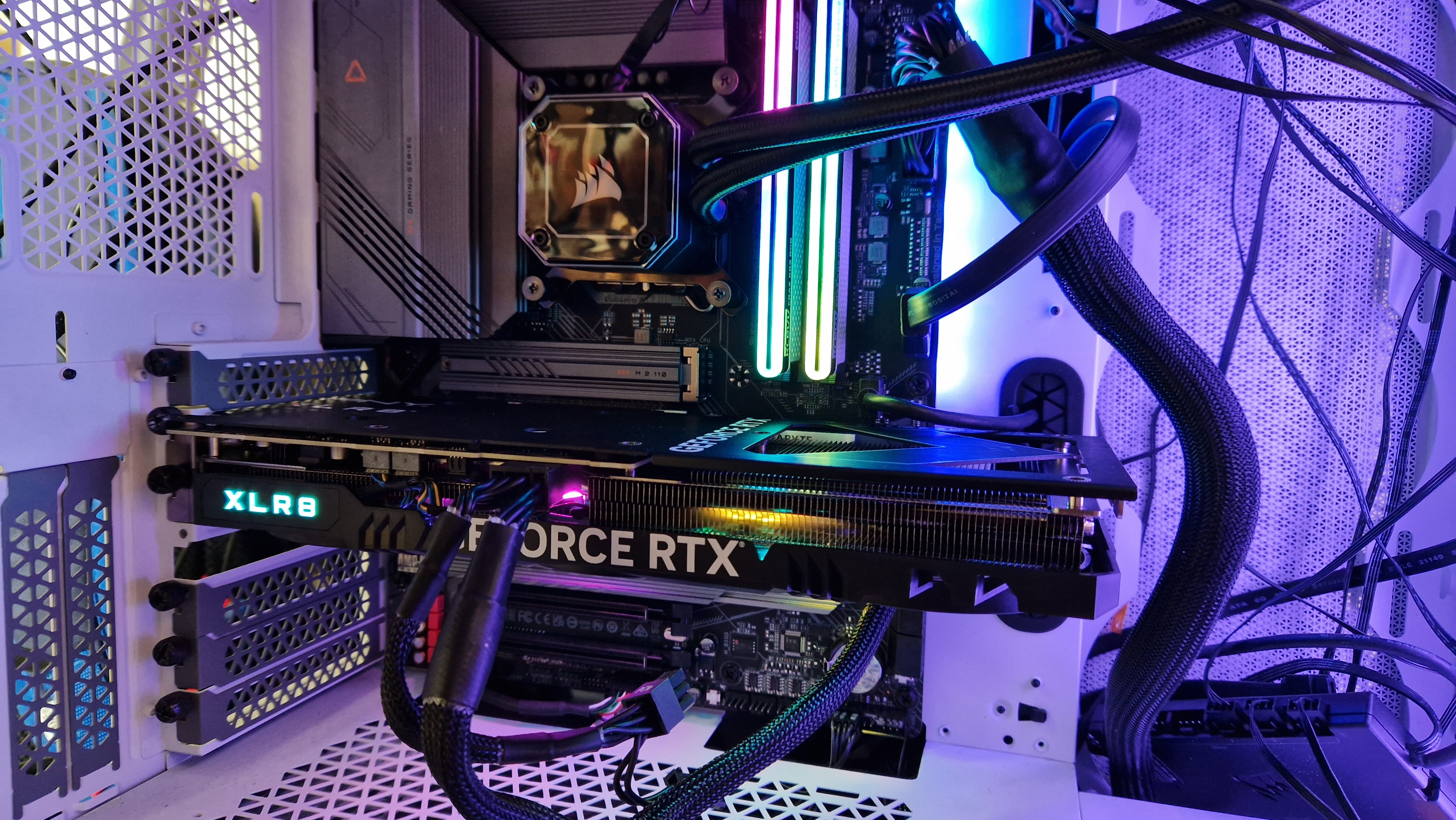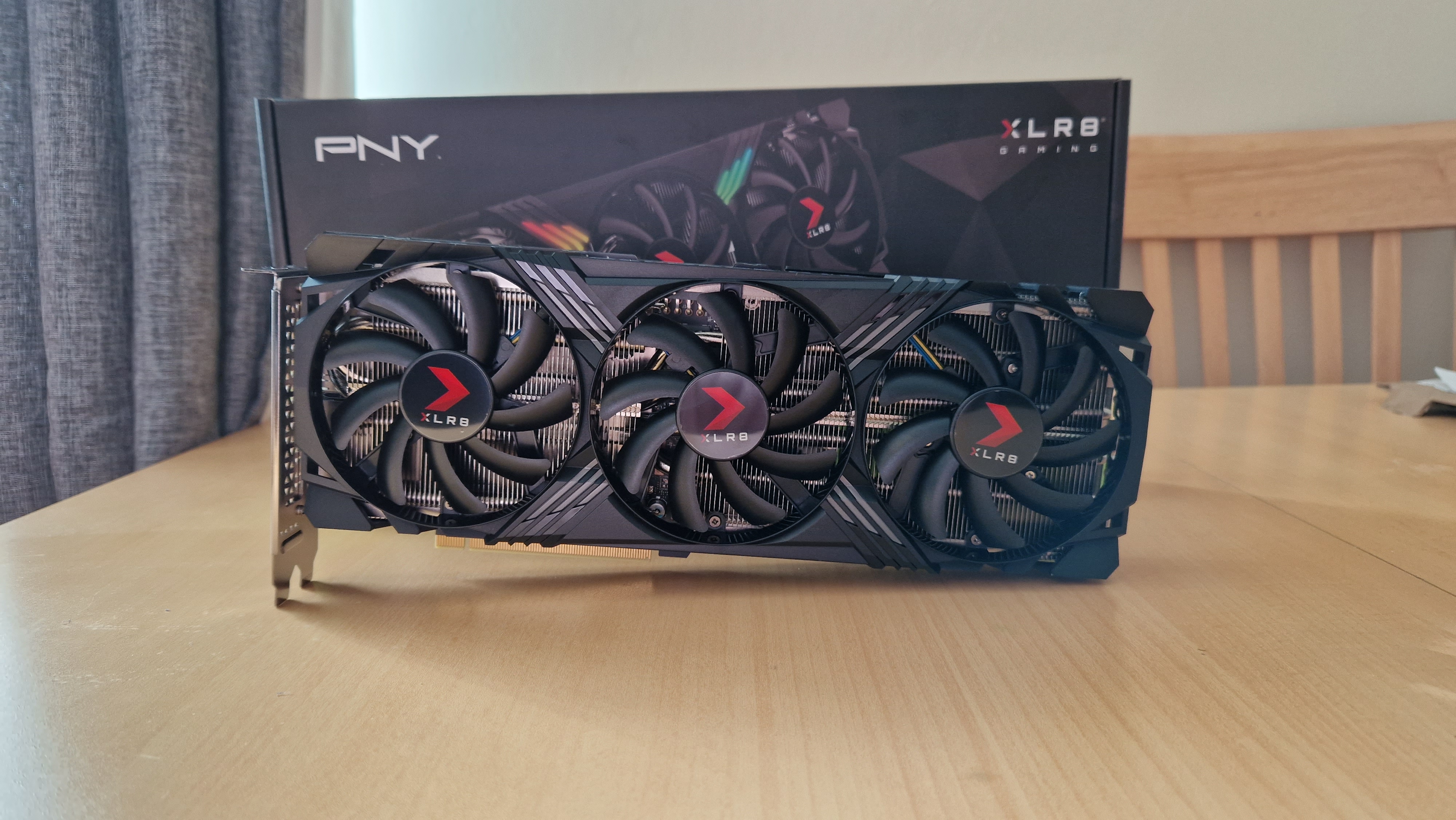GamesRadar+ Verdict
The PNY GeForce RTX 4070 is a great graphics card that blows any reason for buying the RTX 4070 Ti out of the water. With great performances in 1440p and some respectable frame rates in 4K for the money, this is a GPU that's well worth considering. The only real caveat here is that for less money, you could wait until July and get more VRAM in a 4060 Ti. We'll leave that up to you.
Pros
- +
Great in-game performance
- +
Some respectable 4K frame rates
- +
Lovely design
- +
Performance is not far off a 4070 Ti and it's way cheaper
Cons
- -
PNY model is one of the more expensive ones
- -
4060 Ti is on the way with more VRAM
Why you can trust GamesRadar+
We're a little late to the party in reviewing the PNY GeForce RTX 4070. While it's a shame we couldn't get a card to review for launch day, in some ways, that's actually a good thing. We've just heard all about the RTX 4060 family, which means we're better placed for this review now that we know where the 4070 will sit price-wise compared to the lower-end 40 Series cards.
This is important, because the pricing of the best graphics cards has been something of a hot topic this generation. Particularly in my review of the PNY GeForce RTX 4070 Ti, I felt like for the first time, we had a clear indication that Nvidia was knowingly overcharging for its latest GPUs. After all, it "unlaunched" the 12GB 4080, changed nothing in terms of specs or value, then repurposed it as a 4070 Ti for $100 less. Coming in at $799 / £799, I felt when I reviewed the Ti that it barely warranted that price. After all, if you're going to spend that much on a GPU, you might as well spend a bit more and get something that, a) has more VRAM, and b) doesn't rely on DLSS to stay competitive with the likes of the AMD Radeon RX 7900 XT.
Thankfully, the RTX 4070 will only set you back an MSRP of $599 / £589, and for performance that isn't far off the Ti version, that price feels much more honest. Interestingly, the launch model of the 4060 Ti will have 8GB of VRAM, down from the 4070's 12GB of GDDR6X. However, another version launching in July will set you back $499 and will contain 16GB of GDDR6 VRAM.
I'm actually a big fan of PNY's Nvidia GeForce RTX 4070. It feels like an authentic entry in the Lovelace line-up that was overdue after the unattainable prices of the last few years. With the 60 family so close to launch though, and more VRAM being a tempting prospect for less money, there's an interesting buying decision to be made here.
Design and Features
PNY has some of the most well-rounded designs in the GPU market, at least in my opinion. This XLR8 RTX 4070 is no exception, because although it's a slightly lighter, slimmer body than the 4070 Ti I reviewed not long ago, it has some stunning RGB highlights that go hand in hand with other components that are found in the best gaming PCs.
The 4070 can be found in twin-fan form factors - both from PNY and other manufacturers. The one I've tested is a triple fan, dual slot model that fits right into PNY's XLR8 range in terms of its design. Dimensions come in at 12.01 x 4.7 x 1.57-inches. Do note, that extra cooling will set the price slightly above MSRP, with it costing $619.99 as far as I can see. If you're trying to get as close to that suggested price as possible, shoot for the dual-fan model which is set at $599 at the time of writing.

In terms of connectivity and features, you'll benefit from pretty much exactly what you'd expect if you've been keeping up to date with the RTX 40 series. There's one HDMI 2.1 port, three DisplayPort 1.4 bays, and for power, one 8-pin PCIe connector.
Your average Lovelace architecture keeps the engine running here, safe with all the various bells and whistles that entails. DLSS 3.0 functionality is the same here as it is on the other 40 series boards, and I'm glad to say that it doesn't feel like as much of a cheap magic trick as it did with the Ti. For a higher-end board price-wise, I just felt that the Ti shouldn't need to rely on DLSS quite as much as it does to stay competitive in 4K. Yes, it is predominantly geared at 1440p according to Nvidia, but looking at its place in the wider market, and its higher price, it should be more than capable of keeping up with the 7900 XT in 4K without the help of DLSS.

Regardless, DLSS felt more like a genuine helping hand with the 4070, and not like it was two-thirds of what you were paying for.
Let's talk architecture then - that 12GB of GDDR6X VRAM is propped up by 4th Generation Tensor Cores, and 3rd Generation RT Cores. You have 5888 CUDA Cores, a clock speed of 1920MHz, and a boost speed of 2475MHz. The memory interface is 192-bit, has a bandwidth of 504GB/sec, and a TDP of 200W.
With this model in particular PNY gives you access to Velocity X Overclocking software, too.

Performance
Onto performance, then. As a broad overview, I'm actually really happy with the way this GPU handled our benchmarking games. Being the centre of the 40 Series family, it'd be all too easy for the 4070 to suffer from middle child syndrome - identity crises where it's the jack-of-all-resolutions and master of none. I don't see it that way at all though, and just in case my last sentence didn't have enough cliches for you, here's another. The RTX 4070 feels like a happy medium in the Lovelace line-up, and to me, that means it's a success.
For the money, which, yes, is still perhaps a bit much when you compare the pricing and specs to the RTX 4060 and 4060 Ti, I feel like this is the best value 40 series card yet. That said, it will be up to you whether you shoot for this 4070 - which will give you 3080 performances - or wait until the 4060 Ti with more VRAM launches. From my experience, more VRAM is the thing to look for. Without DLSS, this is the surefire way to guarantee yourself strong in-game performances in higher resolutions.
One thing I can say is that the performance scores below have cemented in my mind that you should not spend the extra money on an RTX 4070 Ti. For the most part, as you'll see from the table below, the extra money gets you ~15fps more on average. For me, that's not worth it. Either save a bit more, grab an RX 7900 XT, or go cheaper and grab a PNY GeForce RTX 4070.
| Game | PNY RTX 4070 | PNY RTX 4070 Ti |
|---|---|---|
| HUNT: Showdown | 120fps | 120fps |
| Apex Legends | 210fps | 225fps |
| Control | 70fps (120fps with DLSS) | 120fps |
| Shadow of the Tomb Raider | 160fps (220fps with DLSS) | N/A |
| Metro Exodus | 115fps (155fps with DLSS) | 120fps |
As you can see from my testing, the RTX 4070 is neck-and-neck with the Ti at 1440p. Besides about 15fps more in Apex Legends, there really isn't any reason I can see for people who play games in Quad HD to shell out extra cash for the Ti model. For the money, the 4070 is probably the best-value 1440p card on the market right now. These games all had settings turned up to max, with Ray Tracing turned on where possible.
You may notice an anomaly in that the 4070 actually outperformed the Ti in Metro Exodus. In fairness, that game seems to be a bit of a circuit breaker. When I played it at 4K max settings during my review of the Acer Predator Orion 7000 (2023) it also struggled to get higher frame rates - and that rig had an i9-1300K and an RTX 4090 in it.
But what happens when you boost things up to 4K with the RTX 4070?
| Game | PNY RTX 4070 | PNY RTX 4070 Ti |
|---|---|---|
| HUNT: Showdown | 70fps | 85fps |
| Apex Legends | 140fps | 154fps |
| Control | 70fps (80fps with DLSS) | 30fps (70fps with DLSS) |
| Shadow of the Tomb Raider | 135fps (150fps with DLSS) | N/A |
| Metro Exodus | 57fps (89fps with DLSS) | 87fps (120fps with DLSS) |
Again, it's not a cakewalk for the 4070 Ti, and although there are more consistent wins across the board, I wouldn't say it's an awful lot for the extra hundred or so coin. These are the types of frame rate advantages I've been noticing during our most recent DDR5 RAM reviews when testing if enabling XMP can improve things in-game. They're absolutely not the type of frame rate gains I'd want for that amount of extra money spent on a video card.

One slight anomaly is that the 4070 outperformed the Ti in its organic (non-DLSS) 4K frame rate while playing Control. At this point, I'll also add that since that 4070 Ti review, our testing rig has gone up a generation in CPU, now housing a 13700K Intel CPU as opposed to the equivalent 12th Gen processor. The RAM has also been swapped out and can reach faster speeds, potentially gaining that 15 or so FPS I was alluding to. Combined, these things could be the difference maker - although my god did the 4070 Ti struggle with Control at 4K without DLSS.
For those who need a little more technical mumbo jumbo, here are our most recently reviewed GPUs in some standard benchmarking tests.
| Row 0 - Cell 0 | 3DMark Time Spy (graphics score) | 3DMark Fire Strike | Geekbench OpenCL GPU compute | Geekbench Vulkan GPU compute |
| PNY RTX 4070 | 17 639 | 38 289 | 173510 | 145139 |
| PNY RTX 4070 Ti | 22 793 | 38 042 | 216377 | 168626 |
| AMD RX 7900 XTX | 28 011 | 40 392 | 222987 | 209630 |
| AMD RX 7900 XT | 24 326 | 40 425 | 193584 | 202062 |
Keep in mind, these 4070 scores have been recorded with updated components in the rig, so a better overall score in Fire Strike for the RTX 4070 is likely due to that. When we compare the two Graphics scores of the Ti and 70 in Fire Strike, the Ti takes it 54 135 to the 4070's 43 965.

Should you buy the PNY RTX 4070?
I found it really difficult to recommend the RTX 4070 Ti - both in terms of its raw performance in games and because of the controversies around its pricing. In reviewing the PNY RTX 4070, that recommendation has become harder still. The RTX 4070 is a much better value card all things considered, and I see no real reason to spend the extra cash on the Ti version when you won't see significant gains in your frame rates in 1440p or 4K.
But enough about the bigger sibling or the 4070 will actually start suffering from middle child syndrome. The RTX 4070 is capable of excellent gaming performance at 1440p, and is probably the best value prospect for that resolution until we get our hands on the RTX 4060 and 4060 Ti. In particular, I'd look to July for that 16GB of VRAM model, because if you tend to play games that don't have DLSS support, that might be a better raw performer for you.

Especially with the price of the 60 family being significantly less, it makes it difficult to fully recommend the 70. Do I think this graphics card is more worthy of your time and money than the 4070 Ti, though? One hundred percent, yes. Will it give you great performances in 1440p and respectable 4K performances? Yes it will. I'm a fan of this graphics card, and I think it might end up being one of the best of the Lovelace lot when the full range is accounted for.
For me, this middle child is the one to send to college.
How we tested the PNY RTX 4070
I put the PNY RTX 4070 through its paces in our testing PC which houses a 13th Gen Intel Core i7-13700K CPU, 32GB of Klevv Crass DDR5 RAM, a PNY CS1030 SSD - all seated to a Gigabyte Z690 Gaming X motherboard.
I played various benchmarking games at 1440p and 4K while recording frame rate averages, closely comparing to my experience of reviewing the RTX 4070 Ti. To test Ray Tracing performance and DLSS, I played Metro Exodus, Shadow of the Tomb Raider, and Control. To test how the GPU fares in competitive multiplayer games that don't have Ray Tracing or DLSS, I played Hunt Showdown and Apex Legends. These games are often played by folks who want as many FPS as possible to give them the edge, so I think it's important to include these games in testing too.
To hear more about the ways we test the latest gaming tech for our reviews, consult the GamesRadar Hardware Policy.
Loading up your rig with next-gen components? Grab one of the best CPUs for gaming, some of the best RAM for gaming, and the best SSD for gaming.
One of my earliest memories is playing SuperMario64 and wondering why the controller I held had three grips, but I only had two hands. Ever since I've been in love with video games and their technology. After graduating from Edinburgh Napier University with a degree in Journalism, I contributed to the Scottish Games Network and completed an Editorial Internship at Expert Reviews. Over the last decade, I’ve been managing my own YouTube channel about my love of games too. These days, I'm one of the resident hardware nerds at GamesRadar+, and I take the lead on our coverage of gaming PCs, VR, controllers, gaming chairs, and content creation gear. Now, I better stop myself here before I get talking about my favourite games like HUNT: Showdown, Dishonored, and Towerfall Ascension.



